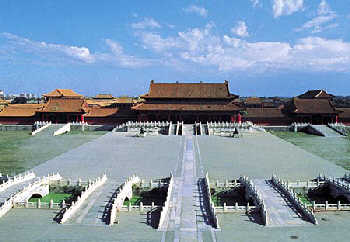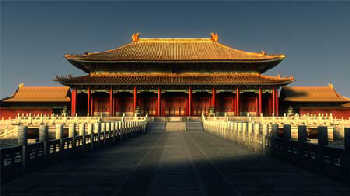

On the annual Winter Solstice (22nd solar term), the Summer Solstice (10th solar term), the Spring Equinox (4th solar term), and Autumnal Equinox (16th solar term), the emperor went to Tiantan, Ditan, Ritan and Yuetan respectively to perform sacrificial rites. The correspondence of Tiantan, Ditan, Ritan and Yuetan, winter, Summer, spring and autumn, south, north, east and west demonstrated the ancient Chinese world outlook on the integration of man and heaven.
Expansion of the south to the outer city greatly prolonged the city's axis. In line with the total length of the axial line stretching from south to north, the composition of the picture of the entire city can be divided into three major sections: The first section started from Yongdingmen to Zhengyangmen in the middle of the southern wall of the outer city, and was the longest. Its rhythm was the most gentle. The second section was shorter and strongly made, running from Zhengyangmen to jingshan through the square in front of the palace and the entire palatial city, where lay the climax. The third section ran from Jingshan to the Bell andDrum towers, and was the shortest. Europeans have often said that architecture is solidified music. If architecture is to be compared to music, then all the three sections in of gray tiles and walls and they are all placed amidst green trees, presenting patterned beauty. In his work entitled the Design of City, the British writer Edmond Bacon said that perhaps Beijing is the greatest human single work on the earth's surface. This Chinese city was designed to be the residence of the emperor with the intention of making it a symbolic center of the world. Its brilliant and splendid design provides a rich source of design ideas for today's cities.
The Forbidden City is the second section of the city of Beijing, running from Damingmen (no longer existing, the starting-point of the palatial zone to the north of Zhengya- ngmen , through Huangcheng and Gongcheng in the north to the peak of Jingshan Hill. The axis is 2,500 meters long and can be divided into three smaller sections again similar to a symphony of three movements--prelude, climax and coda. The first is the longest, stretching from Damingmen to Wumen in the front gate of Gongcheng, consisting of three squares strung together in front of the Palace, serving as the leading space. The second is the Forbidden City itself, composed of the three parts of Qianchao (front court), Houqin (back bedroom) and Yuhuayuan (imperial garden), which is the climax; the third is the shortest, stretching from Shenwumen, the north gate of the Forbidden City, to Wanchun Pavilion, the peak of jingshan. -I-he artistic role and artistic methods of each section, and of each sector of various sections, are different, however They are linked to, and echo each other They were accomplished in one go to jointly serve the theme of playing up the imperial authority.

Copyright ©1999-2011 Chinanews.com. All rights reserved.
Reproduction in whole or in part without permission is prohibited.